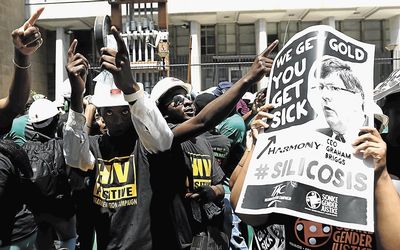THE High Court in Johannesburg’s Friday certification of the silicosis class action was only the first step on a very long road to compensation for mine workers suffering the debilitating effects of silicosis. But it was momentous.
By certifying the class action, the court — a full bench of three judges — has given the green light to an enormous group of litigants to sue, in a single case, the gold mining industry for what they say was decades of sacrificing their health to the pursuit of profit. There are between 17,000 and 500,000 of them.
SA has had class actions before, but this one is different.
Usually a class of litigants will sue a single defendant, and usually it will be for a one-off wrongful act. Here, the lawsuit is against almost every gold mining company, including their parent companies. And it will cover their conduct over years — from 1965 to last year.
The claims could run to billions of rand.
The mine workers hope to show that — through the Chamber of Mines — the gold mining companies acted "in concert" in breaching their duties to protect the workers from the effects of silica dust, which causes silicosis and increases the risk of tuberculosis (TB).
The class action trial — if and when it happens — will literally be putting the gold mining industry, the historical bedrock of SA’s wealth, on trial.
In Friday’s judgment, penned by Deputy Judge President Phineas Mojapelo and Judge Bashier Vally, the judges said that, as gold mining caused SA’s wealth to grow, "the industry left in its trail tens of thousands, if not hundreds of thousands, of current and former underground mine workers who suffered from debilitating and incurable silicosis and pulmonary tuberculosis".
The judgment lists all the evidence the mine workers want to bring forward that would be common to all the individual cases. This includes evidence that gold mining companies disregarded safety legislation introduced in 1965 and, in doing so, acted in concert under the auspices of the Chamber of Mines. And that, until as late as 2008, the gold mining companies showed "serial and pervasive noncompliance" with dust-control laws.
The evidence that will be submitted at trial will try to reveal how the mines’ racist and discriminatory practices meant black workers, who earned salaries at 10% of their white counterparts, suffered silicosis and TB disproportionately to white mine workers, and the companies avoided accountability and compensation as a result of the migrant labour system.
Referring to affidavits filed in court by mine workers, the judges said: "With remarkable consistency, their evidence reveals that the mining companies stripped them of their dignity, and concomitantly compromised their health and safety, with such intensity and ferocity that they were effectively dehumanised."
At this point, all this evidence is allegation only.
It will have to be tested and evaluated against the evidence put up by the mining companies. Already during the certification hearing, counsel for the mining companies argued the evidence offered by the mine workers was so weak that they had failed to make out even a prima facie case.
In Friday’s judgment, the judges acknowledged that for the mine workers to succeed, their case would "entail and traverse novel and complex issues of fact and law". What certification means is that these novel and complex issues, the evaluation and testing of the evidence, will happen only once.
The court agreed that for the vast majority of the mine workers — most of them are poor, ill and living in far-flung places across the sub-continent — the class action was the only realistic chance of their making a claim for compensation. To deny the class action would be to deny them access to courts — something the courts "should be very careful" about, said the judges.
The court agreed to a two-phase court case. In the first phase, the trial court can deal with the issues that all the claimants would have to prove; in the second, the court would with the individual aspects of each mine worker’s case.

Hundreds of people, some of them former miners, march for compensation for illnesses they say were contracted working in mines, in Johannesburg, 2015. Picture: THE TIMES
THE High Court in Johannesburg’s Friday certification of the silicosis class action was only the first step on a very long road to compensation for mine workers suffering the debilitating effects of silicosis. But it was momentous.
By certifying the class action, the court — a full bench of three judges — has given the green light to an enormous group of litigants to sue, in a single case, the gold mining industry for what they say was decades of sacrificing their health to the pursuit of profit. There are between 17,000 and 500,000 of them.
SA has had class actions before, but this one is different.
Usually a class of litigants will sue a single defendant, and usually it will be for a one-off wrongful act. Here, the lawsuit is against almost every gold mining company, including their parent companies. And it will cover their conduct over years — from 1965 to last year.
The claims could run to billions of rand.
The mine workers hope to show that — through the Chamber of Mines — the gold mining companies acted "in concert" in breaching their duties to protect the workers from the effects of silica dust, which causes silicosis and increases the risk of tuberculosis (TB).
The class action trial — if and when it happens — will literally be putting the gold mining industry, the historical bedrock of SA’s wealth, on trial.
In Friday’s judgment, penned by Deputy Judge President Phineas Mojapelo and Judge Bashier Vally, the judges said that, as gold mining caused SA’s wealth to grow, "the industry left in its trail tens of thousands, if not hundreds of thousands, of current and former underground mine workers who suffered from debilitating and incurable silicosis and pulmonary tuberculosis".
The judgment lists all the evidence the mine workers want to bring forward that would be common to all the individual cases. This includes evidence that gold mining companies disregarded safety legislation introduced in 1965 and, in doing so, acted in concert under the auspices of the Chamber of Mines. And that, until as late as 2008, the gold mining companies showed "serial and pervasive noncompliance" with dust-control laws.
The evidence that will be submitted at trial will try to reveal how the mines’ racist and discriminatory practices meant black workers, who earned salaries at 10% of their white counterparts, suffered silicosis and TB disproportionately to white mine workers, and the companies avoided accountability and compensation as a result of the migrant labour system.
Referring to affidavits filed in court by mine workers, the judges said: "With remarkable consistency, their evidence reveals that the mining companies stripped them of their dignity, and concomitantly compromised their health and safety, with such intensity and ferocity that they were effectively dehumanised."
At this point, all this evidence is allegation only.
It will have to be tested and evaluated against the evidence put up by the mining companies. Already during the certification hearing, counsel for the mining companies argued the evidence offered by the mine workers was so weak that they had failed to make out even a prima facie case.
In Friday’s judgment, the judges acknowledged that for the mine workers to succeed, their case would "entail and traverse novel and complex issues of fact and law". What certification means is that these novel and complex issues, the evaluation and testing of the evidence, will happen only once.
The court agreed that for the vast majority of the mine workers — most of them are poor, ill and living in far-flung places across the sub-continent — the class action was the only realistic chance of their making a claim for compensation. To deny the class action would be to deny them access to courts — something the courts "should be very careful" about, said the judges.
The court agreed to a two-phase court case. In the first phase, the trial court can deal with the issues that all the claimants would have to prove; in the second, the court would with the individual aspects of each mine worker’s case.




















